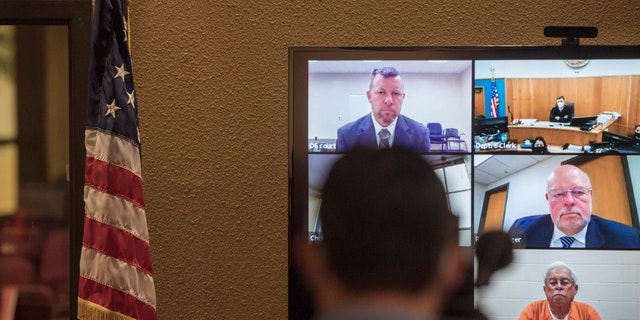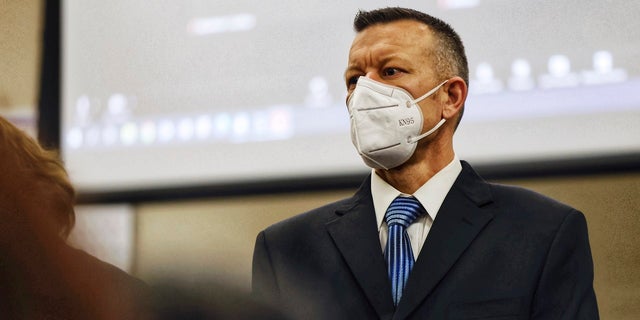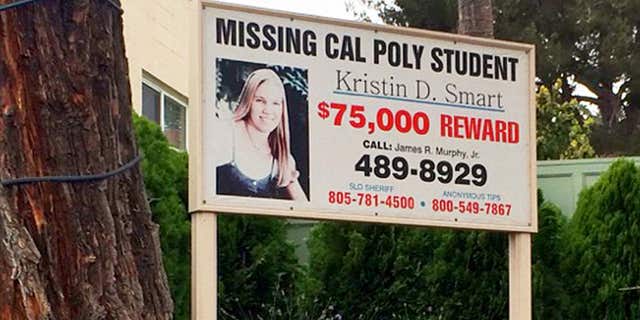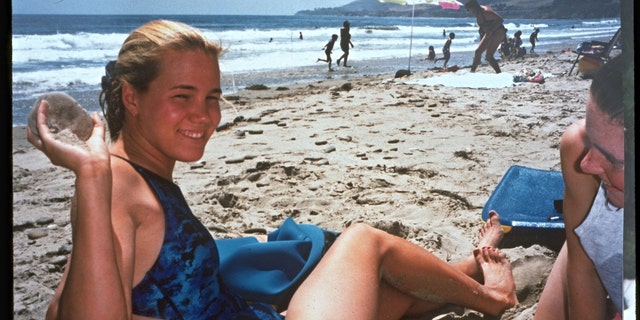Kristin Smart California trial juror sobs during testimony about suspected burial in soil disturbance: Report
An archeologist’s testimony about soil disturbances and signs of a possible burial on the property of one of the men accused in Kristin Smart’s disappearance brought a California juror to tears as the expert described “decomposition stains” and other unusual findings, according to reports.
Cindy Arrington took the stand on Thursday morning and spent the duration of the day’s trial proceedings testifying about her findings from the property belonging to Ruben Flores, who is accused of helping his son, Paul Flores, bury the remains of longtime missing college student Kristin Smart.
“The body was encapsulated in something. A coffin, a tarp, a bag.”
Kristin Smart was a 19-year-old college student at California Polytechnic State University in 1996 when she vanished after an off-campus party, investigators have said. More than 26 years later, Paul Flores – the man who was last seen with Smart – and his father, are standing trial on charges related to her presumed death.
Paul Flores, now 45, has been charged with Smart’s murder. Ruben Flores, his 81-year-old father, was charged with acting as an accessory after the fact for allegedly helping his son hide her body.
KRISTIN SMART TRIAL: EXPERT TESTIFIES ABOUT 6-FOOT BY 4-FOOT ‘ANOMALY’ DETECTED UNDERGROUND AT SUSPECT’S HOME
The trial proceedings are not being televised or live-streamed, pursuant to a judge’s ruling. A handful of journalists — including the person behind the “Your Own Backyard” (YOB) Podcast that is credited with renewing interest in the case — have been reporting from inside the courtroom amid the media limitations.
Prosecutors allege Ruben Flores helped his son bury Smart’s body under the deck of his Arroyo Grande home – and then later removed and relocated her remains when law enforcement returned decades later.
KRISTIN SMART TRIAL: CALIFORNIA JURY HEARS FROM POLICE ABOUT PHONE WIRETAPS AGAINST MURDER SUSPECT PAUL FLORES
As part of their efforts, law enforcement enlisted the help of archeologists, such as Arrington, to examine the soil. Arrington said she has been involved in “hundreds” of excavation investigations in her career, the YOB Podcast tweeted.
“First, we take a close look at the surface to see if there are any signs of disturbance. Then we start removing the soil very slowly. One of the first things that will appear [in a burial] is a stain. Liquids spread out and leave a stain around the remains,” she said, according to the report. “We go slower once we see that. We take all of the dirt around it, and leave the skeleton intact, so you can see exactly how it was buried.”
She described how “most bodies” that are not stored in a coffin are buried in the fetal position, in which case the “stain takes on an oval shape around the body. It stays rather close to the body,” the podcast tweeted.
The stained soil takes on a different color than the surrounding soil, she reportedly went on.
“It is a very distinct color change. Very sharp,” she went on, according to the report.
Asked how she can tell when a hole was previously dug, she said she looks for signs of “stratigraphy.”
“The natural process of how soils are laid out,” she explained, according to the report. “A layering effect. If an area has never been disturbed, you have very beautiful lines in the soil.”
Arrington said her company – which she co-owns with previous expert Paul Hanes – was enlisted in March and April 2021 to analyze the ground with ground penetrating radar technology. They then began excavating after discovering anomalies in the soil, YOB Podcast reported.
KRISTIN SMART TRIAL: CALIFORNIA NEIGHBORS RECALL ‘UNUSUAL’ ACTIVITY AT HOME WHERE POLICE SAY WOMAN WAS BURIED
Once the excavation started, “I began to see some staining, inconsistent with the surrounding walls of the hole,” Arrington reportedly said.
The expert, who is trained in the study of human bones, said the finding signified that “a hole had been dug there previously.”
KRISTIN SMART TRIAL: CALIFORNIA JURY HEARS FROM PAUL FLORES’ EX-GIRLFRIEND ABOUT STRANGE ENCOUNTER WITH FAMILY
“Some soil had been taken out and put back in. The continuity was jumbled. It tells me there had been a previous hole dug. The staining should have been a nice bowl shape, but was now not. The soil had been disrupted,” she went on, according to the report.
She said she first saw the staining around two feet below the surface and extended just over four feet below. She said its appearance was consistent with other soil stains that resulted from human composition.
“There were no mechanical marks,” she went on, according to the report. “It was not machine-dug, but dug by hand.”
EXAMINING CALIFORNIA’S KRISTIN SMART TRIAL: THE ANATOMY OF A CASE WITH NO BODY
“Did you see staining in this soil that appeared to be from human decomposition?” Deputy District Attorney Christopher Peuvrelle asked.
Arrington responded: “Yes, sir.”
When asked to examine a photograph of soil staining, Arrington testified that it showed that “fluid was leaking, likely from decomposition.”
“You have an irregular pattern where the soil is darker than the soil within it and out of it,” she went on. “Fluid has leaked into the soil slowly over time, not quickly, or the lines would be thicker.”
KRISTIN SMART CALIFORNIA TRIAL: WOMAN TESTIFIES SHE WAS SEXUALLY ASSAULTED BY MURDER SUSPECT PAUL FLORES
She later described how the soil image was “consistent with the hole being re-dug and something taken out.”
The YOB Podcast reporter described how one of the jurors on the panel for Paul Flores’ case began “to loudly and uncontrollably sob,” before the judge called for a lunch break.
Three other jurors were reportedly seen wiping their tears.

Arrington later said she did not find any human or animal bones, but surmised that, “The body was encapsulated in something. A coffin, a tarp, a bag.”
Asked why she would have seen staining in the soil if the body had been wrapped in something, Arrington said the remains could have been placed in a “semi-permeable material,” or there could have been “a small tear or puncture wound in the wrapping,” according to the report.
She reportedly said she did not find any other signs of human decomposition on the property.

On cross-examination, defense attorney Robert Sanger questioned Arrington about whether the disturbances could have been caused by roots, according to the report. She responded that staining “can be left by plant material,” but acknowledged that she did not conduct chemical tests to find out.
She also conceded to Sanger that she did not find a body or any human remains.
“If a body was buried here, it would create quite a substantial odor for the people living there, right?” Sanger, who represents Paul Flores, reportedly asked.
According to the report, Arrington responded: “Substantial odor is subjective. If it was buried shallowly and not wrapped in anything, then yes.”

Defense Attorney Harold Mesick, who represents Paul Flores, asked if there were “lots of explanations for what would cause” such soil stains.
“One would be a decomposing body,” Arrington responded.
Mesick reportedly added: “One could be diesel fuel.”
But Arrington said diesel fuel “has a strong, exacting odor and a distinct color.”
In response to answers from the juries, Arrington said she can not always tell the difference between stains from human decomposition and those coming from animal decomposition.

CLICK HERE TO LISTEN TO TRUE CRIME PODCASTS FROM FOX NEWS
“You would have to have a chemical analysis done by a lab,” she said, according to the report.
When asked if decomposition stations are “always a good indication of a burial,” Arrington reportedly responded: “Yes. You would not have a burial without a decomposition stain.”
Smart was a student at Cal Poly’s San Luis Obispo campus in 1996 when she was allegedly heavily intoxicated, with Paul Flores, after an off-campus party on Crandall Way. She was walked back from the party by three people — two people, a man and woman, and Flores. The others slowly peeled off after Flores allegedly insisted multiple times that he could get Smart home safely.
She was never seen again.
The state has said Flores killed Smart in his dorm room while he tried to rape her when they were both freshmen. The disappearance prompted a massive search.
Dual juries were selected from a pool of more than 1,500 Monterey County residents to oversee each case separately but simultaneously. The trial is expected to last months.
Read the full article Here


